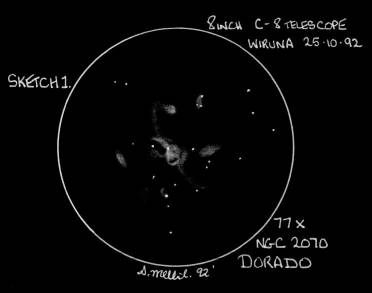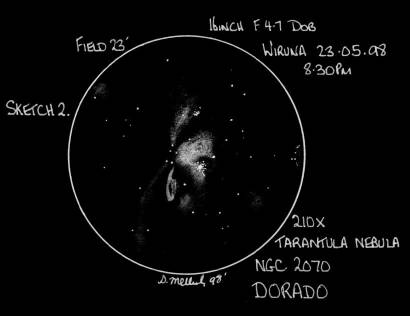SSPM16. The Tarantula Nebula
By Scott Mellish, 1998
NGC 2070 was one deep sky object I have always avoided sketching like the plague. Not because of the difficulty involved, but simply because you can never do justice to the supreme visual pleasure of this noble object. Despite the Milky Way being full of many splendid nebulae, such as The Orion and Lagoon to name a couple, all bow down in shame against the mass of the Tarantula. Situated some 185,000 light years away, and not even in our own galaxy this object is easily viewed with the naked eye. The diameter of the Tarantula is roughly 750 - 800 light years with a mass equivalent to some 520,000 Suns. It is also the strongest source of radio emissions in the entire large Magellanic cloud. In the central region of the object lies a cluster of beautiful stars which are mostly luminous super giants, numbering over a hundred or so. Only a handful could be seen in the 16inch at 210x mag. The only other object known as yet to be anywhere near the scale of NGC 2070 is the huge nebulous region in M33, NGC 604 which is considerably more distant than NGC 2070.
 No doubt there are other galaxies around that support Tarantula sized nebulous regions just waiting to be discovered, unfortunately we will never get to see them in such detail as we do with the Tarantula - even in the smallest of telescopes.
No doubt there are other galaxies around that support Tarantula sized nebulous regions just waiting to be discovered, unfortunately we will never get to see them in such detail as we do with the Tarantula - even in the smallest of telescopes.
The first time I sketched the Tarantula was with the trusty old C-8 I used to own and had many enjoyable observing sessions with. Way back in October 1992 was my first effort at drawing this object (sketch 1) and the result was reasonable. It nearly made the dust bin, however I am now glad I kept it, it is nice to look back on things from time to time. A bit like old photographs. As you can see in the C-8 at 77x it is still a very impressive object, with loops and curls quite evident. It is indeed very easy to understand why it is called the Tarantula Nebula, it does not require too much imagination to conjure a giant spider out of the looping nebulous mass.
In the 16" Dobsonian at 210x mag the Tarantula takes on a whole new form. Many more filaments come into view with 8 inches more aperture, and the term 'aperture fever' can be understood when you observe complex objects like NGC 2070. I have not used an Oxy III filter on the nebula very often, as such a wondrous object such as this needs no aid to produce its beautiful form.
As the LMC is an irregular galaxy, it does not have any core region, however the Great Tarantula Nebula certainly makes a perfect substitute. Being an H II region the hydrogen within is ionized by the starlight of the many super-hot resident stars. NGC 2070 appears brighter than the stars it encompasses, because it has reaped its luminosity from their plentiful but unseen ultraviolet radiation, converting it into visible light. At the moment there are enough stars in the Tarantula Nebula to illuminate this extraordinary region of gas which is around 900 light years across.
 If stars have been forming within the Tarantula Nebula during the lifetime of the LMC then the nebula has a very good claim to be called the nucleus of the galaxy. Even as we observe the nebula today it is the most enormous accumulation of glowing hydrogen within the Large Magellanic Cloud and I would have no hesitation in calling it the heart of the galaxy .
If stars have been forming within the Tarantula Nebula during the lifetime of the LMC then the nebula has a very good claim to be called the nucleus of the galaxy. Even as we observe the nebula today it is the most enormous accumulation of glowing hydrogen within the Large Magellanic Cloud and I would have no hesitation in calling it the heart of the galaxy .
The accompanying sketches, although copies of originals give a good idea of the increasing complexity of the nebulosity as you double the aperture, making it a visual treat in large telescopes. This does not mean however that it is any less noble in smaller telescopes. So, whatever size scope you own, take your time and really give the Tarantula a good going over in all its glory.
Clear Skies

